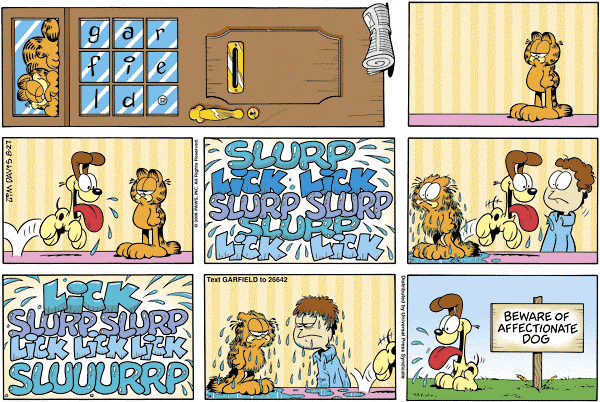
At a glance, it may be a standard-issue "These Days Everybody Is On The Internet!" joke. Garfield is usually surprisingly in-touch with technology for a strip about a cat and a guy sitting around at a table; it's in a rare league with Dilbert and Fox Trot of strips that don't blow it every time a computer appears. Everybody Is On The Internet is not a particularly offensive or ignorant joke anyway, and this one comes with added Garfield venom.
Everybody is on the Internet, even those people with no real reason to be. If there is any knowledge or entertainment to be gained from the official Tabasco Sauce website, we are hard pressed to find it. Garfield's joke points out that not only is everyone on the Internet, and not only do they not need websites, but some individuals and experiences cannot/ should not be translated to the medium. The dog is so swept up in the perception of a website as modern necessity, that he contradicts the purpose of his sign in the first place, namely as a warning to avoid the dog. As a MAD Magazine fold-out poster said, "DO NOT READ THIS SIGN".
The strip confirms the central hollowness of virtual replacement for real-world experience, no matter how miserable (e.g.- getting bitten by a crazy dog). All Garfield has to see is "www" before glancing out at his audience to confirm our mutual disgust. Do not read this Internet.



 Affection in Garfield is an aggressive emotion, its most frequent expressions normally portrayed as unwelcome and overbearing. In its most common manifestations, we see Jon's desperation for love from Liz, and companionship and respect from Garfield, Odie's indiscriminate attacks of physical ardor, Nermal's narcissistic longing for praise and attention. This is not to say it is a negative, or destructive impulse, just that the infrequency of characters exhibiting reciprocity to caring and understanding give affection a specific power and commodity in the world as Garfield sees it. The means by which Garfield copes with this shortage is to channel desire into aesthetic passion for food, sleep, TV, flowers, etc., which he variously decimates or overindulges and exhausts the love-object. This is less self-delusory than an act of self-deprivation; in the interest of sustaining control over his surroundings and self, Garfield eliminates from his nature those desires which cannot be reliably self-fulfilled. In effort to maintain his Cool, love takes a backseat.
Affection in Garfield is an aggressive emotion, its most frequent expressions normally portrayed as unwelcome and overbearing. In its most common manifestations, we see Jon's desperation for love from Liz, and companionship and respect from Garfield, Odie's indiscriminate attacks of physical ardor, Nermal's narcissistic longing for praise and attention. This is not to say it is a negative, or destructive impulse, just that the infrequency of characters exhibiting reciprocity to caring and understanding give affection a specific power and commodity in the world as Garfield sees it. The means by which Garfield copes with this shortage is to channel desire into aesthetic passion for food, sleep, TV, flowers, etc., which he variously decimates or overindulges and exhausts the love-object. This is less self-delusory than an act of self-deprivation; in the interest of sustaining control over his surroundings and self, Garfield eliminates from his nature those desires which cannot be reliably self-fulfilled. In effort to maintain his Cool, love takes a backseat.


